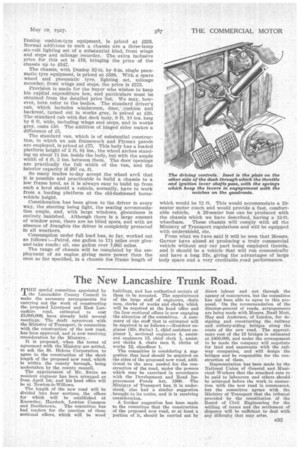The New Lancashire Trunk Road.
Page 61

If you've noticed an error in this article please click here to report it so we can fix it.
T"special committee appointed by the Lancashire County Council to make the necessary arrangements for carrying out the work of constructing the proposed Liverpool and East Lancashire road, estimated to cost £3,000,000, have already held several meetings. The draft agreement with the Ministry of Transport, in connection with the construction of the new road, has been approved, and is now receiving consideration by the Ministry.
It is proposed, when the terms of agreement with the Ministry are settled, to ask the St. Helens Corporation to agree to the construction of the short length of the proposed new road, which is within the county borough, being undertaken by the county council.
The appointment of Mr. Swire as resident engineer, has been arranged as from April 1st, and his head office will be at Newton-le-Willows.
The length of the new road will be divided into four sections, the offices for which will be established at Knowsley, Haydock, Lowton Common and Boothstown. The committee has had tenders for the erection of these sectional offices, which will be wood buildings, and has authorized certain of them to be accepted. The appointment of the large staff of engineers, chain men, clerks of works and clerks, whicl will be required at the head office and the four sectional offices is now engaging the attention of the committee. A summary of the staff that is estimated will be required is as follows :—Resident engineer (Mr. Swire) 1, chief assistant engineer 1, sectional engineers 4, assistant engineers 15, chief clerk 1, assistant clerks 4, chain men 8, clerks of works 12, chauffeur 1.
The committee is considering a suggestion that land should he acquired on the sides of the proposed new road, additional to the area needed for the construction of the road, under the powers which may be exercised in accordance with the Development and Road Improvement Funds Act, 1909. The Ministry of Transport has, it is understood, also had a similar suggestion brought to its notice, and it is receiving consideration.
A further suggestion has been made to the committee that the construction of the proposed new road, or at least a portion of it, should be carried out by direct labour and not through the agency of contractors, but the committee has not been able to agree to this proposal. ' On the recommendation of the director-general of roads, arrangements are being made with Messrs. Basil Mott, Hay and Anderson, of London, for designing and constructing the railway and colliery-siding bridges along the route of the new road. The approximate cost of the 15 bridges is estimated at £400,000, and under the arrangement to be made the company will negotiate for land and easements with the railway companies, and will design the bridges and be responsible for the construction of them.
Representation has been made by the National Union of General and Municipal Workers that the standard rate to be paid to labourers and others should be arranged before the work in connection with the new road is commenced, but the committee agrees with the Ministry of Transport that the tribunal provided by the constitution of the Board of Civil Engineering for the settling of terms and the settlement of disputes will be sufficient to deal with any difficulty that may arise.




















































































































